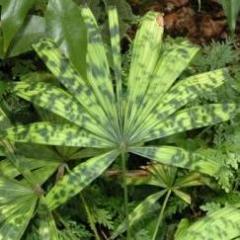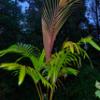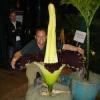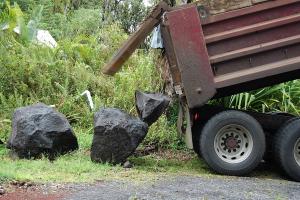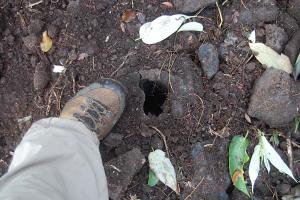Leaderboard
Popular Content
Showing content with the highest reputation on 03/26/2010 in all areas
-
Dear Palm enthusiasts, I would like to start discussion on what techniques and media members use to germinate their palms seeds Media types and percentages ie Perlite 50%, Peatmoss 50% etc How you prepare the seeds ie soak in water or other treatments and lastly what type of container, plastic pot with sealed plastic bag, polystyrene fruit box, tupperware container etc I know that there will be great variations in what people use and it depends on your environment and climate but at least it is a good start to share with others Please share your successes and failures Regards wanderanwills1 point
-
So many palms, so little time. Steve and I spent last week on the big island of Hawaii -- some of you may have seen our Napau Crater Hike posted by Bo in the Travel Logs section. Everything in Hawaii is quite dramatic: giant crashing waves, big erupting volcanoes, huge craters, long hikes, lots of mosquitos!!! I met a woman last week who said, "Oh, yeah, Cindy Anderson calls it mega-gardening!" I got my first taste of that over the last few days. We had simple plans: --select a few boulders for the garden --get some more cinder-soil delivered --move the stump of the tree that blew over --clear out the front planting area better --plant some screening palms around the water tank --plant some screening palms along the neighbor's new fence --do something fun!! Phase one: boulders. We went early one rainy morning to Sanford's quarry, just up the road past a couple of steam vents (yes, we are definitely on a volcano!). No camera, which I dearly regret, it was so incredibly exciting!! I am awed by the huge earth-moving, rock-sorting, and crushing machinery! Wow, talk about men and boys and the size of their toys, it was incredible to see these big machines poke and prod these massive boulders, then pick then up and gently lay them down in the bed of an enormous truck! (Okay, so, maybe I'm easily impressed...) Here are the boulders being delivered -- not so easy to shake them out of the truck: Kind of like waiting for a chicken to lay an egg...1 point
-
- 10:34AM: For a few customers, it was their first time visiting Montgomery Botanical Center and a SFPS palm & cycad sale, so they found it a lot to take in at one time. I talked to one couple who live right down the street and had no idea that the center existed here, not to mention the collection of plants residing within. It is a mutual fact, that both newcomers to palms and veteran collectors enjoy some free seed and a free palm, or two. - "Yeah Dude!" IPS Director, Vendor #50 and FM. Faith Bishock (budrot) takes a moment to pose with her friend Jim in her booth. - 10:35AM: A nice grab was made by FM. Randy Wiesner (palmisland) as he brought over a nice sized Dypsis lastelliana in a 3 gallon pot. I didn't notice the palm on my first look through earlier in the morning. It had a nice coloration on the emergent petiole and rachis. - 10:38AM: An eager collector reaches through the crowded front table in the booth to grab a tall Orania ravaka [obscured] at the back of the table. They had been reading the card for a while and once they asked if it was the only one, they went for it. Ryan1 point
-
- 10:30AM: The Dypsis prestoniana was more than ready to go into the ground, as it was almost root bound in the pot. Those petioles are more than an inch (2cm) in diameter. - 10:32AM: Customers continued to arrive and plants continued to leave throughout the morning hours. A few of the vendors and customers noticed the usual society BBQ grill was not present, and wondered what would be for lunch. - 10:33AM: Sold. Jeff Cramer grabs the D. prestoniana with assistance and carries it to the registers. I figure that palm has been planted now for a few days somewhere in Jeff's collection. - Every sale topic deserves the ubiquitous shot of an emerging red leaf on a Chambeyronia macrocarpa. This specimen was doing a good job of selling the smaller plants, but remained in the booth until purchased later. Ryan1 point
-
If you like Corypha utan then seeing at least the intro to the film "Ten Canoes" is a must. Absolutely spectacular.1 point
-
1 point
-
- 10:02AM: I was caught off guard by the sight of these palms, as this species is one you seldom see at plant sales. This is Gaussia princeps, the real deal western Cuba native in all its slow-growing glory. Their stout habit makes the average collector do a double take. They were in Susan Casey's, #26 booth. - 10:04AM: Vendor #35 Steve Stern describes the growth habits of a few different palms to an interested party of customers. - 10:18AM: The cooler weather was definitely customer friendly, as there was little need to find shade. - 10:30AM: "Hmm..." On the right, FM. Jeff Cramer (street124) looks over the large Dypsis prestoniana in the booth that Jeff Searle had originally brought to sell the smaller plants. Jeff Cramer decided to get it, leaving the smaller plants to fend for themselves... Ryan1 point
-
- 9:53AM: The flow of customers picked up a bit after the morning started to turn into noon time. It was a steady flow of customers and locals who were surprised to see the Center open to the public. Many, and I do mean many, turned out to take the tour. Vendor #31 Albert Livingston carries a palm to the holding area. - 10:00AM: If anyone asks you what 'filtered light' resembles, here is your example. The area in front of Faith's booth seemed to attract a lot of attention from passers by, as it was a hub of activity so early in the morning... - The back part of the sales area, or the back 'loop' of booths. It might look slow, but many of the customers were in the booths as it was easier to go from one to the other, without walking across. - 10:01AM: SFPS Director Lenny Goldstein gives a bit of palm info to the volunteer on the left. The society of had a nice spread of free plants and free seed to distribute. Ryan1 point
-
- 9:35AM: Andre is out of the shot on the right adding to his hidden stash, while he carries on a conversation with Jeff and Jamie. On the right, far-traveling Forum member Tom Walsh (tew) had again, made the journey down from Baltimore, Maryland to attend the sale. He has racked up some serious frequent flyer miles in attending the spring sales at Montgomery B. Center. - 9:40AM: "Wow, look at that price!" Jeff reacts to reading the tag and price on a large Hydriastele beguinii brought to the sale by Vendor #50, Faith Bishock. - 9:44AM: In Claude Roatta's booth we had a similar reaction to these Mazari Palms, Nannorrhops ritchieana that were busting at the seams. - 9:51AM: The day included visits from a few recognizable people familiar in the South Florida plant world. Don Evans, long time curator and director of horticulture for Fairchild Tropical Botanic Gardens (now retired) took some time to browse the selections and talk to vendors at the sale. A little after lunch time, Ron Magill, the well-known Miami MetroZoo Communications Director, made his way through the sale. He knows the SFPS and its volunteers through the society's work at the zoo, he also knew his palms fairly well. Ryan1 point
-
- 9:18AM: John proudly holds up his new cycad while looking through the rare smaller plants on the front table. He was one of a few cycad enthusiasts at Montgomery B. Center that were eyeing that plant, he got to the booth early to grab it. - 9:21AM: As the sale approached the official opening time of 9:30, more customers and society volunteers began to arrive. The early customers who were ready to buy had to wait for the registers to be set up and tested. IPS Director and Forum member John Demott (Redland) [r. in white] approaches the sales area in the right of the photo. - 9:22AM: The curse of the holiday cup. When we arrived in the morning, we noticed this holiday-themed plastic cup sitting atop the soil belonging to the larger Licuala peltata var. sumawongii. How did it get there? No one knows, but it seemed to give the feel of a 'sold' tag to customers as many did not ask about the plant. Later in the day, it was 'retired' by Jeff. - 9:23AM: No need to carry or watch your stash of rare palms when your girlfriend wants to do it for you. Andre, the ever-present collector made his way from booth to booth, with his significant other, Jamie, not far behind. Ryan1 point
-
- 9:03AM: "Yoink!" Andre grabs a nice sized Actinokentia divaricata from the selection, as FM. and new grandfather Ellis Brown (EllisB) finishes the tagging of plants. - 9:13AM: As I was making my rounds of the sales area, I went by vendor Claude Roatta's booth to find a few things of interest, including this Roscheria melanochaetes in bloom, sitting above a Ravenea xerophila. - A closer view of the inflorescence as it curves away from the light purplish-pink crownshaft. - 9:17AM: The first customer back in Jeff's booth was one of Montgomery's own. Assistant Curator John Harshaw, a cycad junkie in the best way, looks over the front table while carrying his new Zamia pseudoparasitica. Ryan1 point
-
- 8:53AM: Strange, bizarre, weird... The different adjectives were shared between viewers of this peculiar Chamaedorea with an unusual variegation. The majority of the suckers growing from the bottom were all completely devoid of chlorophyll. - I thought this was a neat idea when I saw it. These are Zamia pseudoparasitica seedlings growing in octagonal net pots. - 8:54AM: Another view of the strangely variegated palm... - 8:55AM: It's nice when you can photograph as you shop. Ellis had custom benches setup to hold all his small pots and conetainers. Ryan1 point
-
- 8:48AM: Let the browsing, shopping and grabbing begin... We had to yet again, don jackets as the cold weather would not go away. On the left, Vendor Ronnie Croci readies his booth as collector Andre Joris and Jeff Searle walk around trying to be the first to spot a deal. - 8:49AM: The front of FM. and Vendor #68 Ellis Brown's booth all ready and full of the rare and rarer. - This large Burretiokentia hapala stood out in front on sentry duty... until someone bought it. - 8:53AM: Time to turn your head sideways and start reading tags. You literally had to read every tag as you never know what you will find, or who will find it before you do. Ryan1 point
-
- 8:31AM: The art vendors scurry about getting their wares ready for the morning... - Vendor Steve Stern brought this Licuala mattanensis var. mapu to sell some of his smaller seedlings. - 8:39AM: A pair of extremely well priced Cuban Petticoat Palms, Copernicia macroglossa, hang out waiting to be sold. And they do get sold quickly. - 8:40AM: Birds! A common sight around South Florida is the feeding flock of White Ibis, Eudocimus albus. They did a number on the insect population. Ryan1 point
-
There were a few customers from far and wide that either drove far or flew to the sale to get palms for back home. They seemed eager to start planting back at the ranch. Yes, I am busy airbrushing out their imperfections... - 8:26AM: The booth was spaced out as much as possible, as we created paths or blocks of plants, usually with a focus specimen on the corners, like this Kentiopsis oliviformis. - The paths were designed to trap and ensnare customers, sort of like how a casino does. We had to clean out the tent of stranded people now and then. - Dypsis fibrosa caught the eyes of the browsing collector, with a new emergent set of red leaves. - The tent protected some of the more sun sensitive palms, while giving us a place to hide from the weather. Those two tall palms to the right of center, were the newly described Pinanga fractiflexa. They have grown very well and easily for a Pinanga in South Florida, and have promise for the landscape. Ryan1 point
-
Hello again Kim, I have one question. I was looking at and enjoying your pictures for a second time and noticed something around the base of several palms but most noticeably on the Welfia regia. I am assuming it's fertilizer. Can you tell me what you're using and if it will not harm the recently planted palms? Thanks, Peter Alicehunter -- About planting in a lava tube, I haven't actually done that -- that I know of! A lava tube, from what I have seen, is a large, empty, cavelike tube formed from a river of flowing lava that has cooled on the outside to form the tubular shell. Then when the lava flow has ebbed, it leaves the shell behind in the form of the tube. (You can see a photo of Bo and I standing in a collapsed lava tube in his Napau Hike thread inthe travel section. Or Google 'Thurston Lava Tube' to see an example.) If there is such a formation on my property, I haven't found it, but there are many smaller such "air pockets" in the lava formations, or 'pukas' as they call them, which can make digging a hole very easy. But when planting in one, I have to be sure I can fill the hole with cinder soil, because I don't want the soil to wash away from the roots during a heavy rain. What I've come across more commonly are lava trees, vertical holes in the form of a tree trunk. These are formed when a lava flow hits wet trees and coats them; the trees don't burn right away because they are so wet, so when the lava cools around the trees, and then the flood of lava retreats, you have these vertical lava rock structures remaining. Often they are above ground, making a nice feature for the garden, collecting moss, ferns, and other plants in the nooks and crannies of the rock. I have found numerous deep vertical lava tree holes that extend below ground on my land, and I have not planted in them so far. It's hard to determine how deep they are, and again, filling a deep hole with purchased soil doesn't seem like such a great idea. I should emphasize, this is all new to me! If anyone with more experience would like to add something here, please do. Will I be moving here eventually? At this point, I have no idea -- keeping all options open. Peter, yes, that is cheap fertilizer, 14-14-14, around the base of the palms. I was surprised to learn I should go ahead and use a lot of it. Due to the frequent, heavy rains in the area, the fertilizer won't last long. I really should have bought a slow-release fertilizer, at higher cost, but more efficient use of the content. Another islander has recommended using dolomite to aid in mineral intake. I have a lot to learn about this kind of gardening.1 point
-
If you've experienced germinating coconut, you'll see a shoot come up without any root as Nypa. They can germinated and survive for a while without water. For Nypa, they can't stay in water forever when root more growing. Have to place on ground. I've experiment growing Nypa seedling in swamp last year and this is currently picture.1 point
-
1 point
-
Hello Kris These seeds are same lot as yours. Method I have germinated is filling water a half seed. New leaf should emerge first then root. They need to breath, and ligthing is required. I hold them in 50% shade with morning sunlight. You can fill water a quater or just lay them on moist ground, they can survive.1 point

